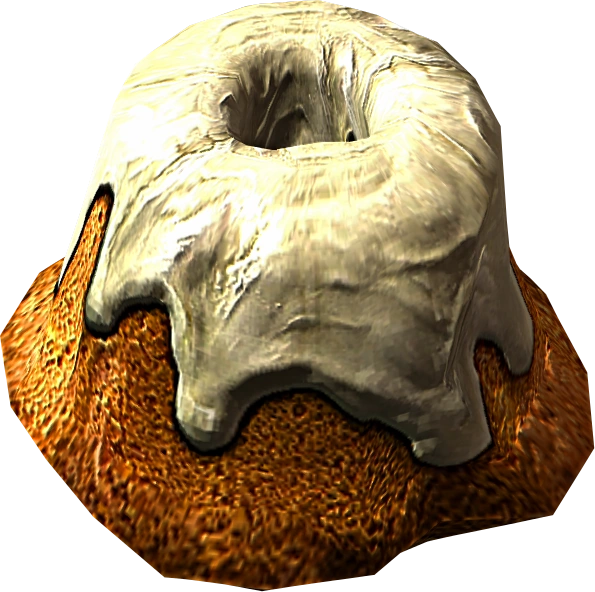I've never been much of a gamer since I was a teenager, but this game is something new and fabulous! One of my characters is an axe-wielding Viking, the other is a dark-skinned woman from a country called Hammerfell who is a magical archer. You can be anyone in this fantastic game, and in the game you complete quests that require fighting bad guys and dragons, and finding hidden treasure in catacombs and caves.
In this game, your character can eat different kinds of food, including treats like the boiled creme treat, apple pies, and--my favourite--sweetrolls!

As pictured, the Skyrim sweetroll looks like a mountain-shaped piece of bread covered in sweet glacé or fondant icing. It's not specified in the game whether it's a bread roll or a cake, because it's simply a background detail. In fact, the only time in the game that it's ever spoken about is when sometimes as incidental dialogue a town guard will say "Let me guess, someone stole your sweetroll".
The sweetroll is a running gag in many games by Skyrim's production company, Bathesda. It seems someone in their design team has a sweet tooth!
Ever since playing it, I wanted to recreate the delicious looking treat. At first, I tried modelling some sweet bread dough into mountain shape rolls, but it never kept its shape on baking. However, the recently I was wandering through my local Lidl and I saw the perfect solution to my problem: a Bundt tin!
Last year, I experimented with making my own tube pan by putting a food can in the middle of a round cake tin. In the blog, I mentioned that Bundt tins are hard to come by here, and are often expensive, but the one I found in Lidl was being flogged off in their reduced section for a princely sum of roughly €5. I was delighted!
This attempt at a sweet roll is a simple vanilla and almond Madeira cake which I then topped off with some melted rolling fondant (I had some leftover from making the Zesteratops, and had read online that it can be melted into pouring fondant. It didn't work as well as I'd wanted to....)
I was super pleased with the results! I was delighted with how clean the details from the Bundt tin came out on the cake itself (I buttered and floured the Hell out of it), and it made a perfectly delicious Skyrim sweetroll, albeit a giant one.
However, I don't believe Vikings, or Medieval princes and princesses, had access to the ingredients to make a modern Madeira cake. I personally believe that an authentic Skyrim sweetroll would actually be a piece of bread with icing on, like a German kugelhopf. I'll try this approach in the future.
Maybe sometime in the future too I could get a mini Bundt tray and make lots of little sweetrolls. Someone has already done that with sponge cake mix, but not with bread. I think further experimentations are in order for bringing the magical world of Skyrim to the real world.
I'll also be doing some experiments with recreating other Skyrim sweets too! Keep your eyes peeled for further Tamriel treats.....




















